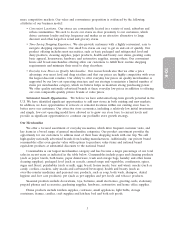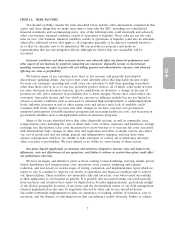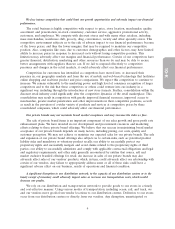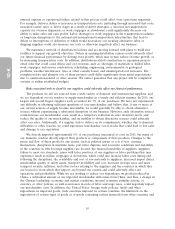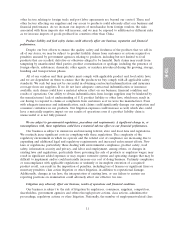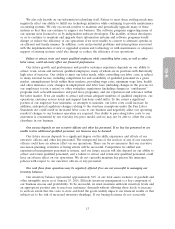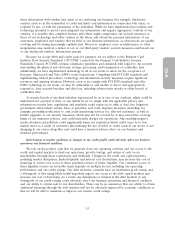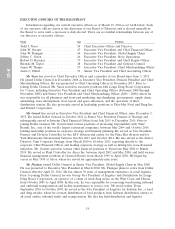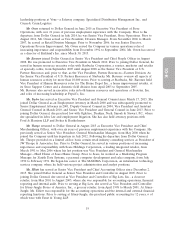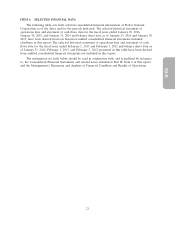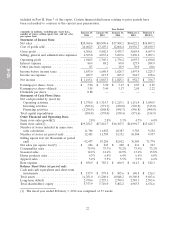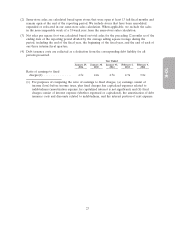Dollar General 2015 Annual Report Download - page 87
Download and view the complete annual report
Please find page 87 of the 2015 Dollar General annual report below. You can navigate through the pages in the report by either clicking on the pages listed below, or by using the keyword search tool below to find specific information within the annual report.
10-K
We also rely heavily on our information technology staff. Failure to meet these staffing needs may
negatively affect our ability to fulfill our technology initiatives while continuing to provide maintenance
on existing systems. We rely on certain vendors to maintain and periodically upgrade many of these
systems so that they can continue to support our business. The software programs supporting many of
our systems were licensed to us by independent software developers. The inability of these developers
or us to continue to maintain and upgrade these information systems and software programs would
disrupt or reduce the efficiency of our operations if we were unable to convert to alternate systems in
an efficient and timely manner. In addition, costs and potential problems and interruptions associated
with the implementation of new or upgraded systems and technology or with maintenance or adequate
support of existing systems could also disrupt or reduce the efficiency of our operations.
Failure to attract, train and retain qualified employees while controlling labor costs, as well as other
labor issues, could adversely affect our financial performance.
Our future growth and performance and positive customer experience depends on our ability to
attract, train, retain and motivate qualified employees, many of whom are in positions with historically
high rates of turnover. Our ability to meet our labor needs, while controlling our labor costs, is subject
to many external factors, including competition for and availability of qualified personnel in a given
market, unemployment levels within those markets, prevailing wage rates, minimum wage laws, health
and other insurance costs, changes in employment and labor laws (including changes in the process for
our employees to join a union) or other workplace regulations (including changes in ‘‘entitlement’’
programs such as health insurance and paid leave programs), and our reputation and relevance within
the labor market. If we are unable to attract and retain adequate numbers of qualified employees, our
operations, customer service levels and support functions could suffer. To the extent a significant
portion of our employee base unionizes, or attempts to unionize, our labor costs could increase. In
addition, anticipated regulatory changes relating to the overtime exemptions under the Fair Labor
Standards Act could result in increased labor costs to our business and negatively affect our operating
results if changes to our business operation are required. Our ability to pass along labor costs to our
customers is constrained by our everyday low price model, and we may not be able to offset the costs
elsewhere in our business.
Our success depends on our executive officers and other key personnel. If we lose key personnel or are
unable to hire additional qualified personnel, our business may be harmed.
Our future success depends to a significant degree on the skills, experience and efforts of our
executive officers and other key personnel. The unexpected loss of the services of any of our executive
officers could have an adverse effect on our operations. There can be no assurance that our executive
succession planning, retention or hiring efforts will be successful. Competition for skilled and
experienced management personnel is intense, and our future success will also depend on our ability to
attract and retain qualified personnel, and a failure to attract and retain new qualified personnel could
have an adverse effect on our operations. We do not currently maintain key person life insurance
policies with respect to our executive officers or key personnel.
Our cash flows from operations may be negatively affected if we are not successful in managing our
inventory balances.
Our inventory balance represented approximately 54% of our total assets exclusive of goodwill and
other intangible assets as of January 29, 2016. Efficient inventory management is a key component of
our business success and profitability. To be successful, we must maintain sufficient inventory levels and
an appropriate product mix to meet our customers’ demands without allowing those levels to increase
to such an extent that the costs to store and hold the goods unduly impacts our financial results or that
subjects us to the risk of increased inventory shrinkage. If our buying decisions do not accurately
13


